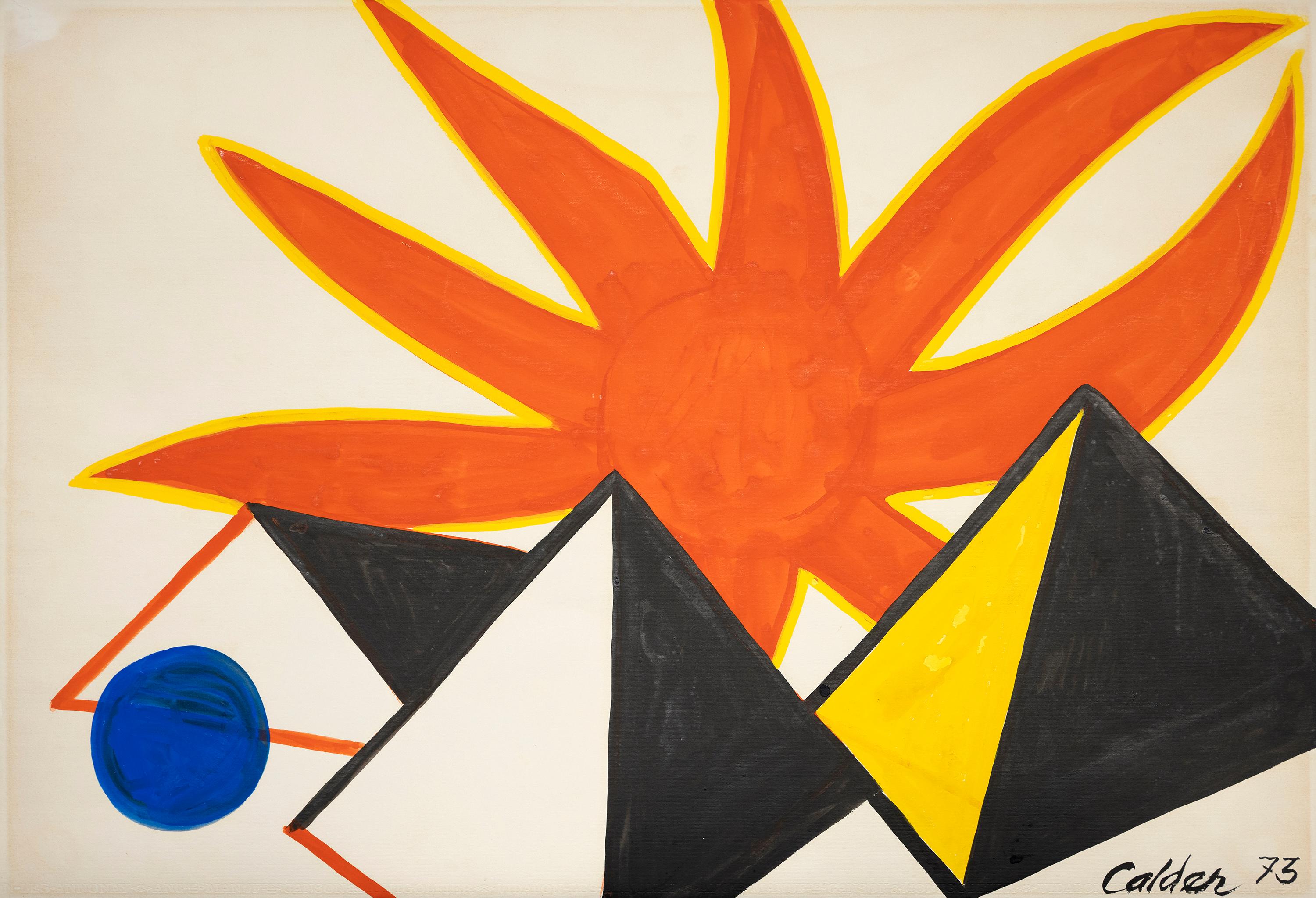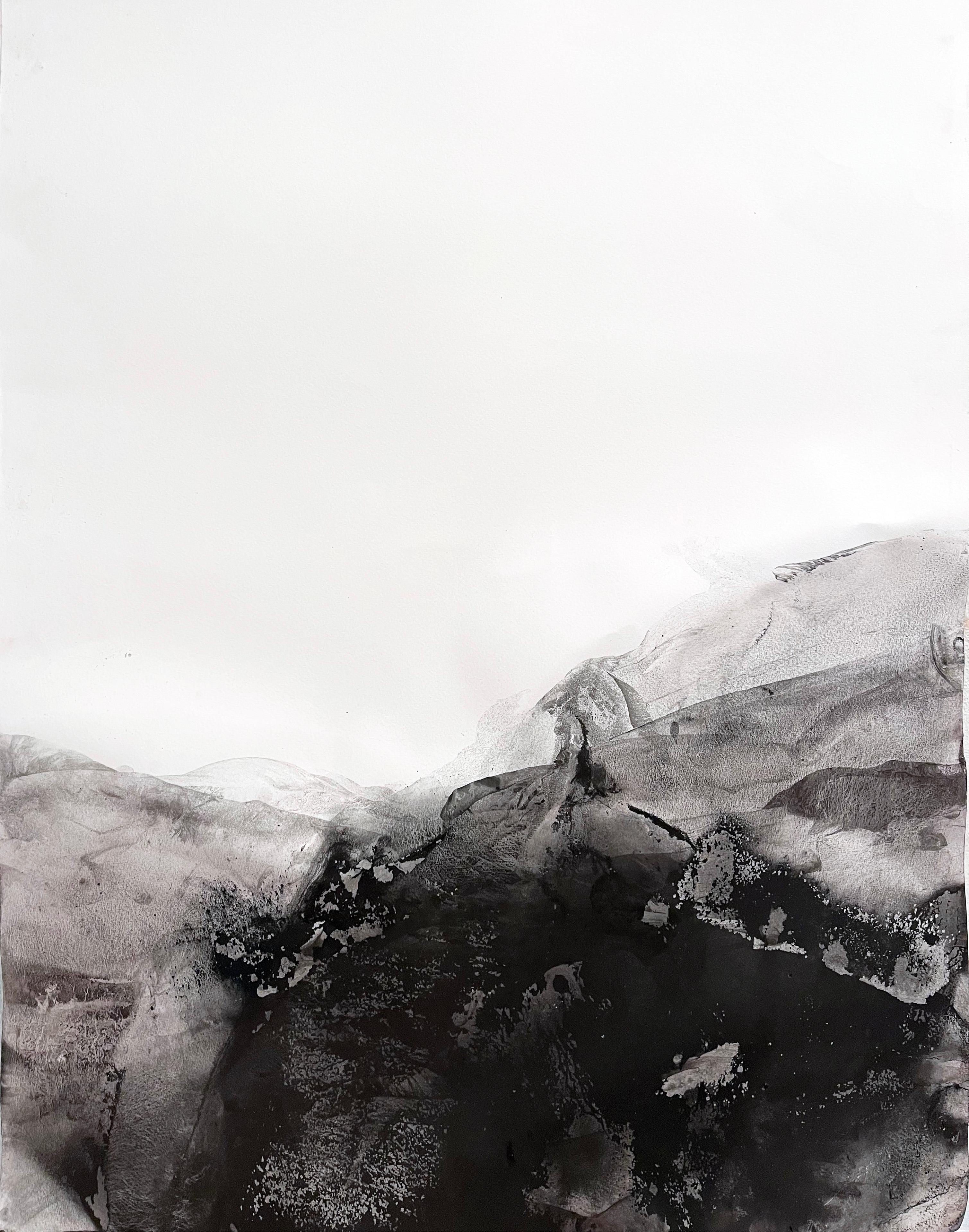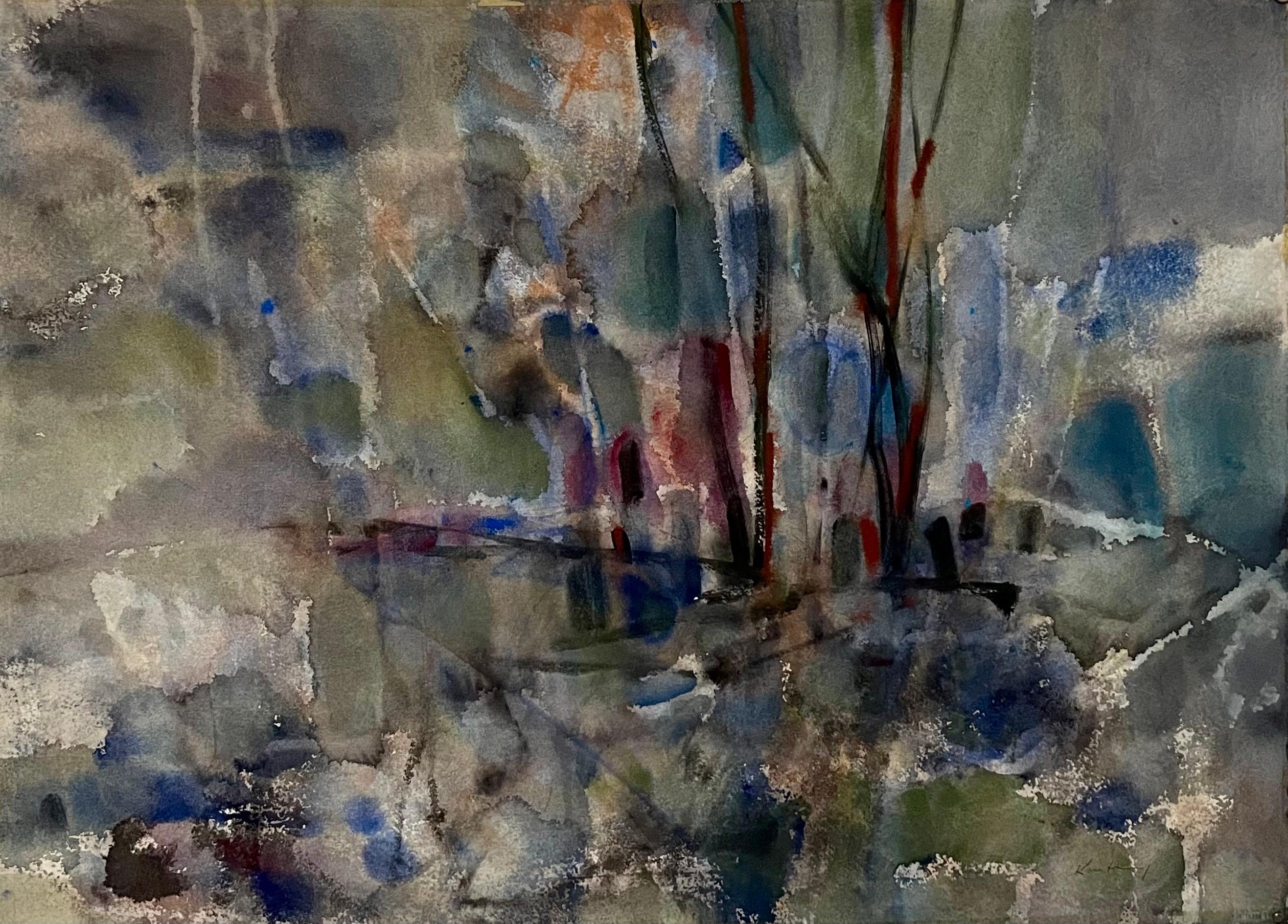Items Similar to Autumn Forest - Mid Century Abstracted Fauvist Landscape
Want more images or videos?
Request additional images or videos from the seller
1 of 11
Emily Shotwell Goeller-WoodAutumn Forest - Mid Century Abstracted Fauvist Landscape c.1947
c.1947
About the Item
Gorgeous mid century fauvist watercolor landscape with lush, vivid trees and distant houses by Emily Shotwell Goeller-Wood (American, 1887-1965). Presented in a rustic giltwood frame. Signed "E. Shotwell Wood" lower right. Image: 16"H x 21"W. Framed: 23.25"H x 28.25"W.
Born in San Francisco, CA on July 30, 1887. Emily Goeller's art studies began at the Mark Hopkins Art Institute, followed by study in Paris under André Lhote, La Montagne St Hubert, Paul Beaudoin, and Jean Despujols; and at at the American Beaux Arts, Fontainebleau. Upon returning to her native city, she was a pupil of Armin Hansen and Frank Van Sloun. She was in NYC in 1919; however, most of her career was spent in northern California where, as a resident of Sausalito, she taught for 30 years at Tamalpais High School. During the 1950s she lived in Nevada City and in 1961 she moved to Sacramento.
She was the widow of F. B. Wood. Her work includes portraits, miniatures, murals, and watercolor landscapes.
Member: Calif. WC Society; SFAA; Marin AA (pres.); SF Women Artists; Calif. Society of Mural Painters. Exh: SF Art Inst., 1909; San Francisco Art Association, 1916-19; Whitney Museum, 1920; Paul Elders (SF), 1924; Salon des Independants (Paris), 1928; SFMA, 1935, 1948; SF Women Artists, 1934-45; Marin AA, 1937-45; Nevada City AA; Kingsley Art Club, 1952. Murals: Sleepy Hollow Golf Club (San Anselmo, CA); Children's Room Hospital (Fontainebleau); San Mateo (CA) Park School Auditorium.
- Creator:Emily Shotwell Goeller-Wood (1887 - 1965, American)
- Creation Year:c.1947
- Dimensions:Height: 23.25 in (59.06 cm)Width: 28.25 in (71.76 cm)Depth: 0.75 in (1.91 cm)
- Medium:
- Movement & Style:
- Period:
- Condition:
- Gallery Location:Soquel, CA
- Reference Number:
About the Seller
4.9
Platinum Seller
These expertly vetted sellers are 1stDibs' most experienced sellers and are rated highest by our customers.
Established in 1986
1stDibs seller since 2014
2,526 sales on 1stDibs
Typical response time: <1 hour
- ShippingRetrieving quote...Ships From: Soquel, CA
- Return PolicyA return for this item may be initiated within 14 days of delivery.
More From This SellerView All
- Fauvist Watercolor Landscape with Weeping Willow TreeBy Les AndersonLocated in Soquel, CAVivid, imaginative colors whirl and swirl together to form this whimsical Fauvist abstracted landscape watercolor, featuring a beautiful weeping willow tree, by Les Anderson (America...Category
1980s Fauvist Landscape Drawings and Watercolors
MaterialsPaper, Watercolor
- Early 20th Century Fauvist Abstracted LandscapeBy Charles Henry HarmonLocated in Soquel, CAA colorful, expressive fauvist watercolor landscape of a pond in the forest (Pan Pacific Exposition Palace Ruins) by Charles Henry Harmon(American, 1895-1936). Presented in a giltwoo...Category
1920s Abstract Impressionist Landscape Drawings and Watercolors
MaterialsPaper, Watercolor
- Wyoming Mountains, Modern Abstract Geometric Landscape WatercolorBy Erle LoranLocated in Soquel, CAWyoming Mountains, Modern Abstract Geometric Landscape Watercolor Energetic modern abstract watercolor in blue and orange hues, by Erle Loran (Ame...Category
1980s Abstract Expressionist Abstract Drawings and Watercolors
MaterialsPaper, Watercolor
- Mid Century Abstract Vertical SunsetBy Irene PattinsonLocated in Soquel, CAAbstract watercolor fragment of a sunset over a field by Irene Pattinson (American, 20th Century). Tag on verso reads "Miller Fine Art / The Estate of Irene Pattinson". Unsigned. Acq...Category
1960s Abstract Expressionist Abstract Drawings and Watercolors
MaterialsWatercolor, Tissue Paper
- "Chimneys at Dusk", Small Pastel San Francisco Abstract Urban LandscapeLocated in Soquel, CAAbstracted Bay Area skyline against a pink sunset creates beautiful and soft geometries in this small pastel urban landscape by San Francisco artist Chris Cacciotti (American, 20th C...Category
1990s Abstract Impressionist Landscape Drawings and Watercolors
MaterialsPaper, Pastel, Watercolor
- Vertical Purple AbstractBy Les AndersonLocated in Soquel, CAAbstract composition by Les Anderson (American, 1928-2009). Unsigned, but was acquired from the estate of Les Anderson in Monterey, California. No frame. Les (Leslie Luverne) Anders...Category
1980s American Impressionist Landscape Drawings and Watercolors
MaterialsPaper, Watercolor
You May Also Like
- Watercolor and Gouache on Paper, by Charles Burchfield, circa 1925Located in New York, NYCharles Burchfield, 1893-1967 Wallpaper Design No.2, 1922-28 Watercolor and gouache on paperCategory
1920s Landscape Drawings and Watercolors
MaterialsPaper, Watercolor, Gouache
- Three Pyramids + Blue BallBy Alexander CalderLocated in Palm Desert, CA"Three Pyramids + Blue Ball" is a gouache on paper by Alexander Calder. The work is signed in the lower right, "Calder 73”. Although renowned for his innovative and groundbreaking sculptures, Alexander Calder started his artistic career as an abstract painter, preferring to use gouache. What is gouache? Gouache is a water-soluble paint – a type of opaque watercolor. As Calder returned to gouache painting towards the end of his life, he was now armed with a lifetime of experience as a sculptor. He explored the three-dimensional vocabulary of sculptural forms he had developed onto the two-dimensional surface of the paper. Certain shapes and colors recur throughout his gouaches and sculptures. Circles, ovals, and other geometric forms dominate the space. There is the same sense of energy and fluidity. The shapes do not sit on the surface but vibrate giving a feeling of movement in contrast to the static nature of painting. Like his sculpture, Calder’s gouache...Category
1970s Abstract Abstract Drawings and Watercolors
MaterialsPaper, Ink, Gouache
- "Landscape" Seascape - Large Size -Contemporary Drawing- Made in ItalyBy Marilina MarchicaLocated in Agrigento, AGlandscape mineral oxide on papers ( Canson Paper 300gr) 75 x110 cm framed artwork, white wood frame, 91X122 cm the edge of the frame is 3.5c m Ready to Hang 2022 Artwork published ...Category
2010s Contemporary Landscape Drawings and Watercolors
MaterialsCharcoal, Gouache, Paper
- Modernist Abstract Expressionist Watercolor Painting Bauhaus Weimar Pawel KontnyBy Pawel KontnyLocated in Surfside, FLAbstract watercolor composition bearing the influence of the earlier color-block compositions of Paul Klee. Pawel August Kontny, (Polish-German-American artist) He was born in Laurahuette, Poland, in 1923, the son of a wealthy pastry shop owner. In 1939 he began studying architecture in Breslau where he was introduced to the European masters and to the work of some of the German Expressionists, soon afterward banned as "degenerate artists" and removed from museums throughout Germany by the Nazi regime. His studies were interrupted by World War II. Drafted into the German army, traveling in many countries as a soldier, he sketched various landscapes but in 1945, he was captured and held as a prisoner of war in Italy. After the war, he studied at the Union of Nuremberg Architects to help design buildings to replace ones destroyed in the war. He recorded his impressions of the local population and the landscapes through his watercolors and drawings. Pawel Kontny thereafter moved to Nuremberg, Germany, becoming a member of the Union of Nuremberg Architects and helping to rebuild the city's historic center. He soon decided to concentrate on his professional art career. He married Irmgard Laurer, a dancer with the Nuremberg Opera. Pavel Kontny 's career as an artist was launched with his participation in an all German exhibition, held at the Dusseldorf Museum in 1952. He held one-man shows in Germany, Switzerland and the United States. During his trip to the United States in 1960, Kontny became instantly enamored with Colorado, and decided to relocate to Cherry Hills with his wife and two children. He quickly established himself in the local art community, being affiliated for a time with Denver Art Galleries and Saks Galleries. His subject matter became the Southwest. During this time he received the Prestigious Gold Medal of the Art Academy of Rome. His extensive travel provided material for the paintings he did using his hallmark marble dust technique. he also worked equally in pastel, watercolor, charcoal and pencil-and-ink. in a style which merged abstraction and realist styles, influenced by Abstract Expressionist painting and South Western American landscapes. This one bears the influence of Sam Francis. In the early 1960s he was one of only a few European-born professional artists in the state, a select group that included Herbert Bayer (1900-1985), a member of the prewar Bauhaus in Weimar and Dessau, Germany, and Roland Detre (1903-2001), a Hungarian modernist painter. As a Denver, Colorado resident, Pavel Kontny exhibited at galleries and museums throughout the United States, Germany and Japan. There, he was inspired by frequent trips to Native American pueblos in the Southwest, as well as by the study of the Plains Indians of Montana and Wyoming. Over the years Kontny had a number of students and generously helped young artist by hosting exhibitions at his Cherry Hills home. For many years he generously donated his paintings to support charitable causes in Denver. Influences during his European years included German pastelist C.O. Muller, German Informel painter Karl Dahmen and Swiss artist, Hans Erni. In the early 1950s his painting style showed the influence of the Die Brücke (The Bridge), a group of German expressionist artists formed in Dresden in 1905 who had a major impact on the evolution of modern art in the twentieth century in Germany. By the middle of the decade his style incorporated more referential abstraction and total abstraction, resulting in part from his study of Hans Hartung, a German artist based in Paris who exhibited his gestural abstract work in Germany. The American moon landing in 1969 inspired Paul Kontny...Category
20th Century American Modern Abstract Drawings and Watercolors
MaterialsWatercolor, Archival Paper
- Modernist Abstract Expressionist Watercolor Painting Bauhaus Weimar Pawel KontnyBy Pawel KontnyLocated in Surfside, FLAbstract watercolor composition bearing the influence of the earlier color-block compositions of Paul Klee. Pawel August Kontny, (Polish-German-American artist) He was born in Laurahuette, Poland, in 1923, the son of a wealthy pastry shop owner. In 1939 he began studying architecture in Breslau where he was introduced to the European masters and to the work of some of the German Expressionists, soon afterward banned as "degenerate artists" and removed from museums throughout Germany by the Nazi regime. His studies were interrupted by World War II. Drafted into the German army, traveling in many countries as a soldier, he sketched various landscapes but in 1945, he was captured and held as a prisoner of war in Italy. After the war, he studied at the Union of Nuremberg Architects to help design buildings to replace ones destroyed in the war. He recorded his impressions of the local population and the landscapes through his watercolors and drawings. Pawel Kontny thereafter moved to Nuremberg, Germany, becoming a member of the Union of Nuremberg Architects and helping to rebuild the city's historic center. He soon decided to concentrate on his professional art career. He married Irmgard Laurer, a dancer with the Nuremberg Opera. Pavel Kontny 's career as an artist was launched with his participation in an all German exhibition, held at the Dusseldorf Museum in 1952. He held one-man shows in Germany, Switzerland and the United States. During his trip to the United States in 1960, Kontny became instantly enamored with Colorado, and decided to relocate to Cherry Hills with his wife and two children. He quickly established himself in the local art community, being affiliated for a time with Denver Art Galleries and Saks Galleries. His subject matter became the Southwest. During this time he received the Prestigious Gold Medal of the Art Academy of Rome. His extensive travel provided material for the paintings he did using his hallmark marble dust technique. he also worked equally in pastel, watercolor, charcoal and pencil-and-ink. in a style which merged abstraction and realist styles, influenced by Abstract Expressionist painting and South Western American landscapes. This one bears the influence of Sam Francis. In the early 1960s he was one of only a few European-born professional artists in the state, a select group that included Herbert Bayer (1900-1985), a member of the prewar Bauhaus in Weimar and Dessau, Germany, and Roland Detre (1903-2001), a Hungarian modernist painter. As a Denver, Colorado resident, Pavel Kontny exhibited at galleries and museums throughout the United States, Germany and Japan. There, he was inspired by frequent trips to Native American pueblos in the Southwest, as well as by the study of the Plains Indians of Montana and Wyoming. Over the years Kontny had a number of students and generously helped young artist by hosting exhibitions at his Cherry Hills home. For many years he generously donated his paintings to support charitable causes in Denver. Influences during his European years included German pastelist C.O. Muller, German Informel painter Karl Dahmen and Swiss artist, Hans Erni. In the early 1950s his painting style showed the influence of the Die Brücke (The Bridge), a group of German expressionist artists formed in Dresden in 1905 who had a major impact on the evolution of modern art in the twentieth century in Germany. By the middle of the decade his style incorporated more referential abstraction and total abstraction, resulting in part from his study of Hans Hartung, a German artist based in Paris who exhibited his gestural abstract work in Germany. The American moon landing in 1969 inspired Paul Kontny...Category
20th Century American Modern Abstract Drawings and Watercolors
MaterialsWatercolor, Archival Paper
- Modernist Abstract Expressionist Watercolor Painting Bauhaus Weimar Pawel KontnyBy Pawel KontnyLocated in Surfside, FLAbstract watercolor composition bearing the influence of the earlier color-block compositions of Paul Klee. Pawel August Kontny, (Polish-German-American artist) He was born in Laurahuette, Poland, in 1923, the son of a wealthy pastry shop owner. In 1939 he began studying architecture in Breslau where he was introduced to the European masters and to the work of some of the German Expressionists, soon afterward banned as "degenerate artists" and removed from museums throughout Germany by the Nazi regime. His studies were interrupted by World War II. Drafted into the German army, traveling in many countries as a soldier, he sketched various landscapes but in 1945, he was captured and held as a prisoner of war in Italy. After the war, he studied at the Union of Nuremberg Architects to help design buildings to replace ones destroyed in the war. He recorded his impressions of the local population and the landscapes through his watercolors and drawings. Pawel Kontny thereafter moved to Nuremberg, Germany, becoming a member of the Union of Nuremberg Architects and helping to rebuild the city's historic center. He soon decided to concentrate on his professional art career. He married Irmgard Laurer, a dancer with the Nuremberg Opera. Pavel Kontny 's career as an artist was launched with his participation in an all German exhibition, held at the Dusseldorf Museum in 1952. He held one-man shows in Germany, Switzerland and the United States. During his trip to the United States in 1960, Kontny became instantly enamored with Colorado, and decided to relocate to Cherry Hills with his wife and two children. He quickly established himself in the local art community, being affiliated for a time with Denver Art Galleries and Saks Galleries. His subject matter became the Southwest. During this time he received the Prestigious Gold Medal of the Art Academy of Rome. His extensive travel provided material for the paintings he did using his hallmark marble dust technique. he also worked equally in pastel, watercolor, charcoal and pencil-and-ink. in a style which merged abstraction and realist styles, influenced by Abstract Expressionist painting and South Western American landscapes. This one bears the influence of Sam Francis. In the early 1960s he was one of only a few European-born professional artists in the state, a select group that included Herbert Bayer (1900-1985), a member of the prewar Bauhaus in Weimar and Dessau, Germany, and Roland Detre (1903-2001), a Hungarian modernist painter. As a Denver, Colorado resident, Pavel Kontny exhibited at galleries and museums throughout the United States, Germany and Japan. There, he was inspired by frequent trips to Native American pueblos in the Southwest, as well as by the study of the Plains Indians of Montana and Wyoming. Over the years Kontny had a number of students and generously helped young artist by hosting exhibitions at his Cherry Hills home. For many years he generously donated his paintings to support charitable causes in Denver. Influences during his European years included German pastelist C.O. Muller, German Informel painter Karl Dahmen and Swiss artist, Hans Erni. In the early 1950s his painting style showed the influence of the Die Brücke (The Bridge), a group of German expressionist artists formed in Dresden in 1905 who had a major impact on the evolution of modern art in the twentieth century in Germany. By the middle of the decade his style incorporated more referential abstraction and total abstraction, resulting in part from his study of Hans Hartung, a German artist based in Paris who exhibited his gestural abstract work in Germany. The American moon landing in 1969 inspired Paul Kontny...Category
20th Century American Modern Abstract Drawings and Watercolors
MaterialsWatercolor, Archival Paper





